Analysis & Recommendations: Food Service Management Practices Report
VerifiedAdded on 2023/06/18
|18
|5687
|440
Report
AI Summary
This report provides a comprehensive analysis of food service management, focusing on The Golden Chippy restaurant as a case study. It evaluates various food supply chain approaches, principles of effective procurement, and sourcing processes. Analytical tools such as Porter's 4 Corners and SWOT analysis are applied to support management strategies. The report also examines ethical practices in the food service industry and their impact on business success. Furthermore, it assesses management practices within specific food service operations using performance techniques, recommends management alternatives for improvement, and devises solutions for managing shortcomings. Metrics for monitoring implementation plans are also discussed, providing a holistic view of enhancing business operations in the food service sector. Desklib provides similar solved assignments for students.
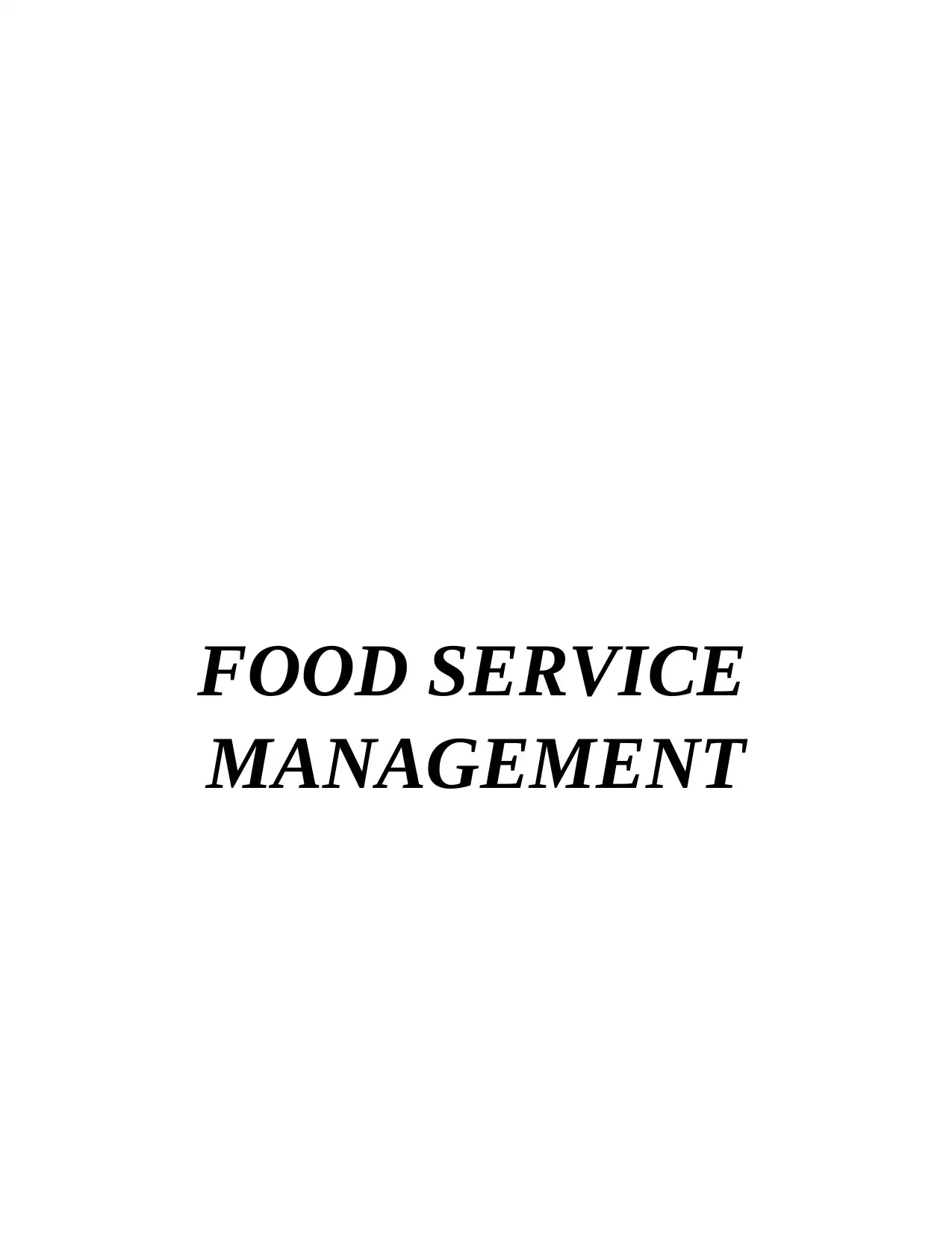
FOOD SERVICE
MANAGEMENT
MANAGEMENT
Paraphrase This Document
Need a fresh take? Get an instant paraphrase of this document with our AI Paraphraser
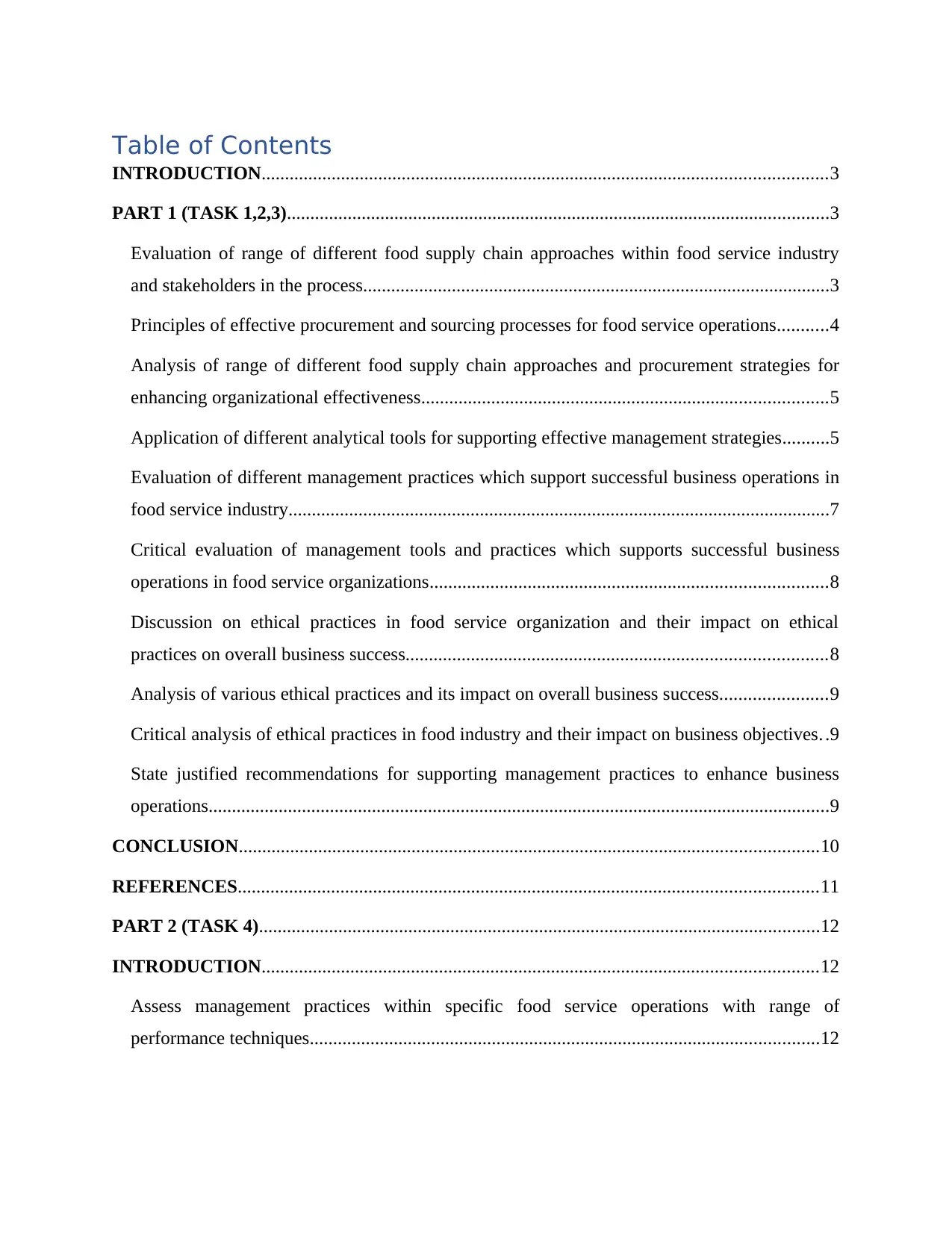
Table of Contents
INTRODUCTION.........................................................................................................................3
PART 1 (TASK 1,2,3)....................................................................................................................3
Evaluation of range of different food supply chain approaches within food service industry
and stakeholders in the process....................................................................................................3
Principles of effective procurement and sourcing processes for food service operations...........4
Analysis of range of different food supply chain approaches and procurement strategies for
enhancing organizational effectiveness.......................................................................................5
Application of different analytical tools for supporting effective management strategies..........5
Evaluation of different management practices which support successful business operations in
food service industry....................................................................................................................7
Critical evaluation of management tools and practices which supports successful business
operations in food service organizations.....................................................................................8
Discussion on ethical practices in food service organization and their impact on ethical
practices on overall business success..........................................................................................8
Analysis of various ethical practices and its impact on overall business success.......................9
Critical analysis of ethical practices in food industry and their impact on business objectives. .9
State justified recommendations for supporting management practices to enhance business
operations.....................................................................................................................................9
CONCLUSION............................................................................................................................10
REFERENCES............................................................................................................................11
PART 2 (TASK 4)........................................................................................................................12
INTRODUCTION.......................................................................................................................12
Assess management practices within specific food service operations with range of
performance techniques.............................................................................................................12
INTRODUCTION.........................................................................................................................3
PART 1 (TASK 1,2,3)....................................................................................................................3
Evaluation of range of different food supply chain approaches within food service industry
and stakeholders in the process....................................................................................................3
Principles of effective procurement and sourcing processes for food service operations...........4
Analysis of range of different food supply chain approaches and procurement strategies for
enhancing organizational effectiveness.......................................................................................5
Application of different analytical tools for supporting effective management strategies..........5
Evaluation of different management practices which support successful business operations in
food service industry....................................................................................................................7
Critical evaluation of management tools and practices which supports successful business
operations in food service organizations.....................................................................................8
Discussion on ethical practices in food service organization and their impact on ethical
practices on overall business success..........................................................................................8
Analysis of various ethical practices and its impact on overall business success.......................9
Critical analysis of ethical practices in food industry and their impact on business objectives. .9
State justified recommendations for supporting management practices to enhance business
operations.....................................................................................................................................9
CONCLUSION............................................................................................................................10
REFERENCES............................................................................................................................11
PART 2 (TASK 4)........................................................................................................................12
INTRODUCTION.......................................................................................................................12
Assess management practices within specific food service operations with range of
performance techniques.............................................................................................................12
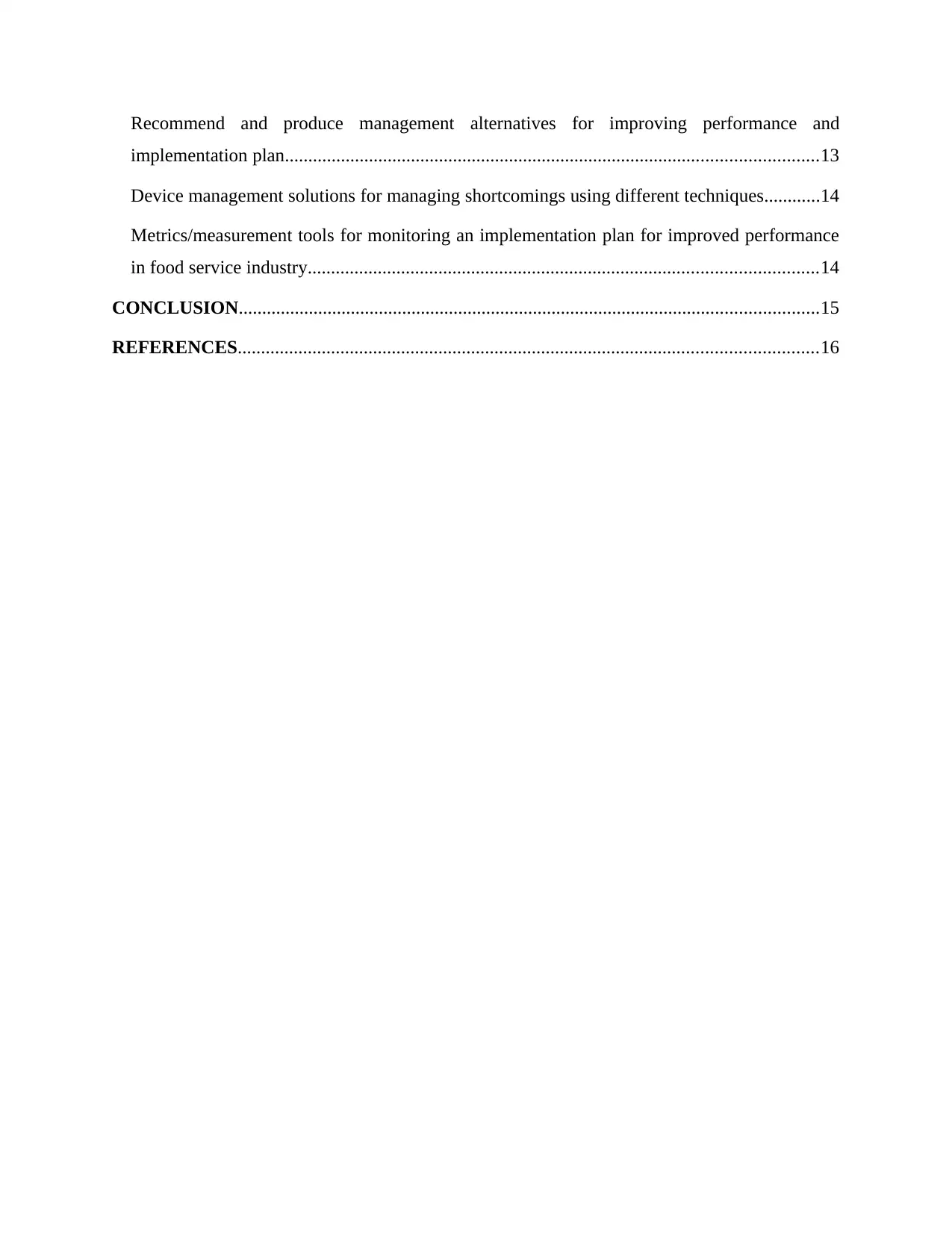
Recommend and produce management alternatives for improving performance and
implementation plan..................................................................................................................13
Device management solutions for managing shortcomings using different techniques............14
Metrics/measurement tools for monitoring an implementation plan for improved performance
in food service industry.............................................................................................................14
CONCLUSION............................................................................................................................15
REFERENCES............................................................................................................................16
implementation plan..................................................................................................................13
Device management solutions for managing shortcomings using different techniques............14
Metrics/measurement tools for monitoring an implementation plan for improved performance
in food service industry.............................................................................................................14
CONCLUSION............................................................................................................................15
REFERENCES............................................................................................................................16
⊘ This is a preview!⊘
Do you want full access?
Subscribe today to unlock all pages.

Trusted by 1+ million students worldwide
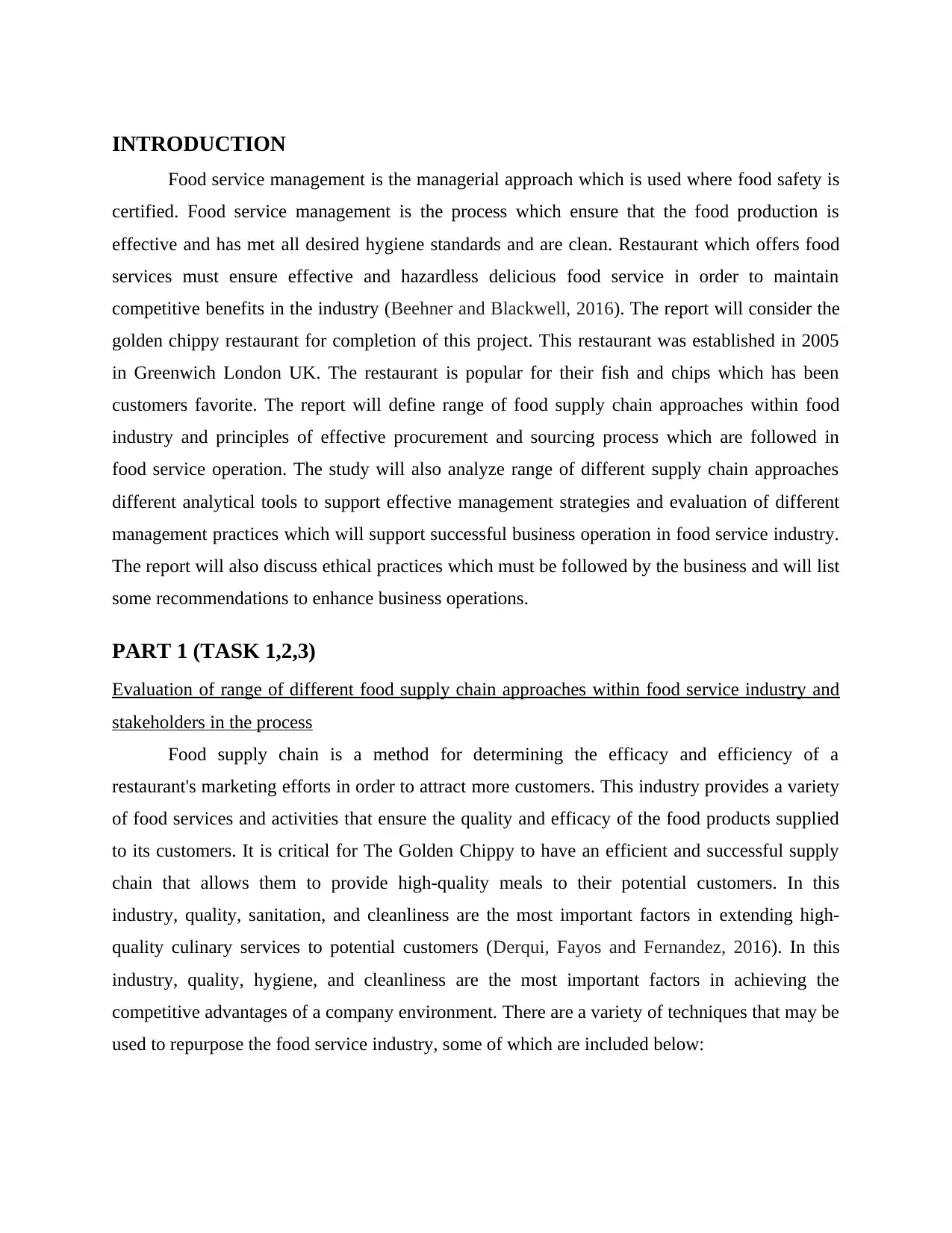
INTRODUCTION
Food service management is the managerial approach which is used where food safety is
certified. Food service management is the process which ensure that the food production is
effective and has met all desired hygiene standards and are clean. Restaurant which offers food
services must ensure effective and hazardless delicious food service in order to maintain
competitive benefits in the industry (Beehner and Blackwell, 2016). The report will consider the
golden chippy restaurant for completion of this project. This restaurant was established in 2005
in Greenwich London UK. The restaurant is popular for their fish and chips which has been
customers favorite. The report will define range of food supply chain approaches within food
industry and principles of effective procurement and sourcing process which are followed in
food service operation. The study will also analyze range of different supply chain approaches
different analytical tools to support effective management strategies and evaluation of different
management practices which will support successful business operation in food service industry.
The report will also discuss ethical practices which must be followed by the business and will list
some recommendations to enhance business operations.
PART 1 (TASK 1,2,3)
Evaluation of range of different food supply chain approaches within food service industry and
stakeholders in the process
Food supply chain is a method for determining the efficacy and efficiency of a
restaurant's marketing efforts in order to attract more customers. This industry provides a variety
of food services and activities that ensure the quality and efficacy of the food products supplied
to its customers. It is critical for The Golden Chippy to have an efficient and successful supply
chain that allows them to provide high-quality meals to their potential customers. In this
industry, quality, sanitation, and cleanliness are the most important factors in extending high-
quality culinary services to potential customers (Derqui, Fayos and Fernandez, 2016). In this
industry, quality, hygiene, and cleanliness are the most important factors in achieving the
competitive advantages of a company environment. There are a variety of techniques that may be
used to repurpose the food service industry, some of which are included below:
Food service management is the managerial approach which is used where food safety is
certified. Food service management is the process which ensure that the food production is
effective and has met all desired hygiene standards and are clean. Restaurant which offers food
services must ensure effective and hazardless delicious food service in order to maintain
competitive benefits in the industry (Beehner and Blackwell, 2016). The report will consider the
golden chippy restaurant for completion of this project. This restaurant was established in 2005
in Greenwich London UK. The restaurant is popular for their fish and chips which has been
customers favorite. The report will define range of food supply chain approaches within food
industry and principles of effective procurement and sourcing process which are followed in
food service operation. The study will also analyze range of different supply chain approaches
different analytical tools to support effective management strategies and evaluation of different
management practices which will support successful business operation in food service industry.
The report will also discuss ethical practices which must be followed by the business and will list
some recommendations to enhance business operations.
PART 1 (TASK 1,2,3)
Evaluation of range of different food supply chain approaches within food service industry and
stakeholders in the process
Food supply chain is a method for determining the efficacy and efficiency of a
restaurant's marketing efforts in order to attract more customers. This industry provides a variety
of food services and activities that ensure the quality and efficacy of the food products supplied
to its customers. It is critical for The Golden Chippy to have an efficient and successful supply
chain that allows them to provide high-quality meals to their potential customers. In this
industry, quality, sanitation, and cleanliness are the most important factors in extending high-
quality culinary services to potential customers (Derqui, Fayos and Fernandez, 2016). In this
industry, quality, hygiene, and cleanliness are the most important factors in achieving the
competitive advantages of a company environment. There are a variety of techniques that may be
used to repurpose the food service industry, some of which are included below:
Paraphrase This Document
Need a fresh take? Get an instant paraphrase of this document with our AI Paraphraser
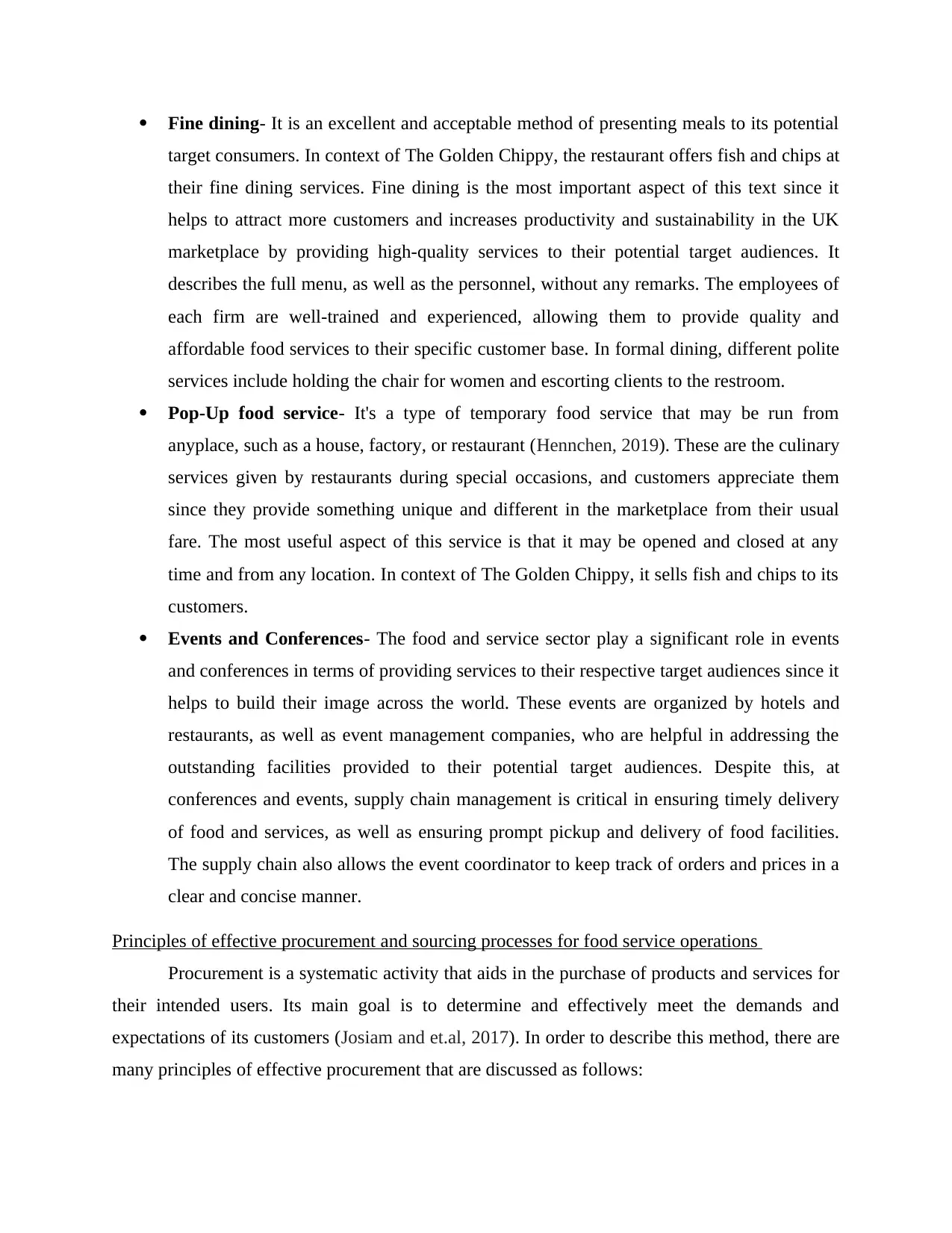
Fine dining- It is an excellent and acceptable method of presenting meals to its potential
target consumers. In context of The Golden Chippy, the restaurant offers fish and chips at
their fine dining services. Fine dining is the most important aspect of this text since it
helps to attract more customers and increases productivity and sustainability in the UK
marketplace by providing high-quality services to their potential target audiences. It
describes the full menu, as well as the personnel, without any remarks. The employees of
each firm are well-trained and experienced, allowing them to provide quality and
affordable food services to their specific customer base. In formal dining, different polite
services include holding the chair for women and escorting clients to the restroom.
Pop-Up food service- It's a type of temporary food service that may be run from
anyplace, such as a house, factory, or restaurant (Hennchen, 2019). These are the culinary
services given by restaurants during special occasions, and customers appreciate them
since they provide something unique and different in the marketplace from their usual
fare. The most useful aspect of this service is that it may be opened and closed at any
time and from any location. In context of The Golden Chippy, it sells fish and chips to its
customers.
Events and Conferences- The food and service sector play a significant role in events
and conferences in terms of providing services to their respective target audiences since it
helps to build their image across the world. These events are organized by hotels and
restaurants, as well as event management companies, who are helpful in addressing the
outstanding facilities provided to their potential target audiences. Despite this, at
conferences and events, supply chain management is critical in ensuring timely delivery
of food and services, as well as ensuring prompt pickup and delivery of food facilities.
The supply chain also allows the event coordinator to keep track of orders and prices in a
clear and concise manner.
Principles of effective procurement and sourcing processes for food service operations
Procurement is a systematic activity that aids in the purchase of products and services for
their intended users. Its main goal is to determine and effectively meet the demands and
expectations of its customers (Josiam and et.al, 2017). In order to describe this method, there are
many principles of effective procurement that are discussed as follows:
target consumers. In context of The Golden Chippy, the restaurant offers fish and chips at
their fine dining services. Fine dining is the most important aspect of this text since it
helps to attract more customers and increases productivity and sustainability in the UK
marketplace by providing high-quality services to their potential target audiences. It
describes the full menu, as well as the personnel, without any remarks. The employees of
each firm are well-trained and experienced, allowing them to provide quality and
affordable food services to their specific customer base. In formal dining, different polite
services include holding the chair for women and escorting clients to the restroom.
Pop-Up food service- It's a type of temporary food service that may be run from
anyplace, such as a house, factory, or restaurant (Hennchen, 2019). These are the culinary
services given by restaurants during special occasions, and customers appreciate them
since they provide something unique and different in the marketplace from their usual
fare. The most useful aspect of this service is that it may be opened and closed at any
time and from any location. In context of The Golden Chippy, it sells fish and chips to its
customers.
Events and Conferences- The food and service sector play a significant role in events
and conferences in terms of providing services to their respective target audiences since it
helps to build their image across the world. These events are organized by hotels and
restaurants, as well as event management companies, who are helpful in addressing the
outstanding facilities provided to their potential target audiences. Despite this, at
conferences and events, supply chain management is critical in ensuring timely delivery
of food and services, as well as ensuring prompt pickup and delivery of food facilities.
The supply chain also allows the event coordinator to keep track of orders and prices in a
clear and concise manner.
Principles of effective procurement and sourcing processes for food service operations
Procurement is a systematic activity that aids in the purchase of products and services for
their intended users. Its main goal is to determine and effectively meet the demands and
expectations of its customers (Josiam and et.al, 2017). In order to describe this method, there are
many principles of effective procurement that are discussed as follows:
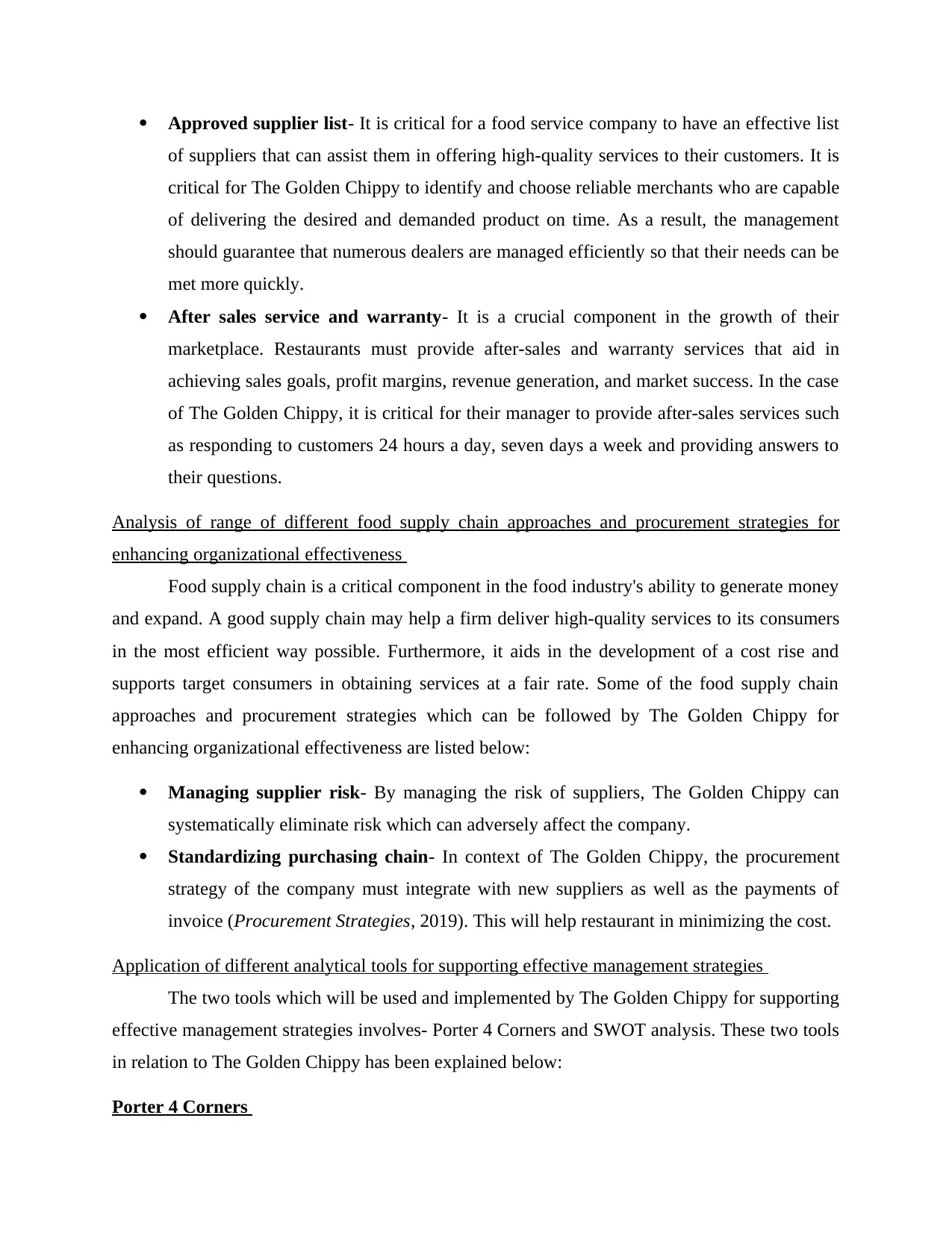
Approved supplier list- It is critical for a food service company to have an effective list
of suppliers that can assist them in offering high-quality services to their customers. It is
critical for The Golden Chippy to identify and choose reliable merchants who are capable
of delivering the desired and demanded product on time. As a result, the management
should guarantee that numerous dealers are managed efficiently so that their needs can be
met more quickly.
After sales service and warranty- It is a crucial component in the growth of their
marketplace. Restaurants must provide after-sales and warranty services that aid in
achieving sales goals, profit margins, revenue generation, and market success. In the case
of The Golden Chippy, it is critical for their manager to provide after-sales services such
as responding to customers 24 hours a day, seven days a week and providing answers to
their questions.
Analysis of range of different food supply chain approaches and procurement strategies for
enhancing organizational effectiveness
Food supply chain is a critical component in the food industry's ability to generate money
and expand. A good supply chain may help a firm deliver high-quality services to its consumers
in the most efficient way possible. Furthermore, it aids in the development of a cost rise and
supports target consumers in obtaining services at a fair rate. Some of the food supply chain
approaches and procurement strategies which can be followed by The Golden Chippy for
enhancing organizational effectiveness are listed below:
Managing supplier risk- By managing the risk of suppliers, The Golden Chippy can
systematically eliminate risk which can adversely affect the company.
Standardizing purchasing chain- In context of The Golden Chippy, the procurement
strategy of the company must integrate with new suppliers as well as the payments of
invoice (Procurement Strategies, 2019). This will help restaurant in minimizing the cost.
Application of different analytical tools for supporting effective management strategies
The two tools which will be used and implemented by The Golden Chippy for supporting
effective management strategies involves- Porter 4 Corners and SWOT analysis. These two tools
in relation to The Golden Chippy has been explained below:
Porter 4 Corners
of suppliers that can assist them in offering high-quality services to their customers. It is
critical for The Golden Chippy to identify and choose reliable merchants who are capable
of delivering the desired and demanded product on time. As a result, the management
should guarantee that numerous dealers are managed efficiently so that their needs can be
met more quickly.
After sales service and warranty- It is a crucial component in the growth of their
marketplace. Restaurants must provide after-sales and warranty services that aid in
achieving sales goals, profit margins, revenue generation, and market success. In the case
of The Golden Chippy, it is critical for their manager to provide after-sales services such
as responding to customers 24 hours a day, seven days a week and providing answers to
their questions.
Analysis of range of different food supply chain approaches and procurement strategies for
enhancing organizational effectiveness
Food supply chain is a critical component in the food industry's ability to generate money
and expand. A good supply chain may help a firm deliver high-quality services to its consumers
in the most efficient way possible. Furthermore, it aids in the development of a cost rise and
supports target consumers in obtaining services at a fair rate. Some of the food supply chain
approaches and procurement strategies which can be followed by The Golden Chippy for
enhancing organizational effectiveness are listed below:
Managing supplier risk- By managing the risk of suppliers, The Golden Chippy can
systematically eliminate risk which can adversely affect the company.
Standardizing purchasing chain- In context of The Golden Chippy, the procurement
strategy of the company must integrate with new suppliers as well as the payments of
invoice (Procurement Strategies, 2019). This will help restaurant in minimizing the cost.
Application of different analytical tools for supporting effective management strategies
The two tools which will be used and implemented by The Golden Chippy for supporting
effective management strategies involves- Porter 4 Corners and SWOT analysis. These two tools
in relation to The Golden Chippy has been explained below:
Porter 4 Corners
⊘ This is a preview!⊘
Do you want full access?
Subscribe today to unlock all pages.

Trusted by 1+ million students worldwide
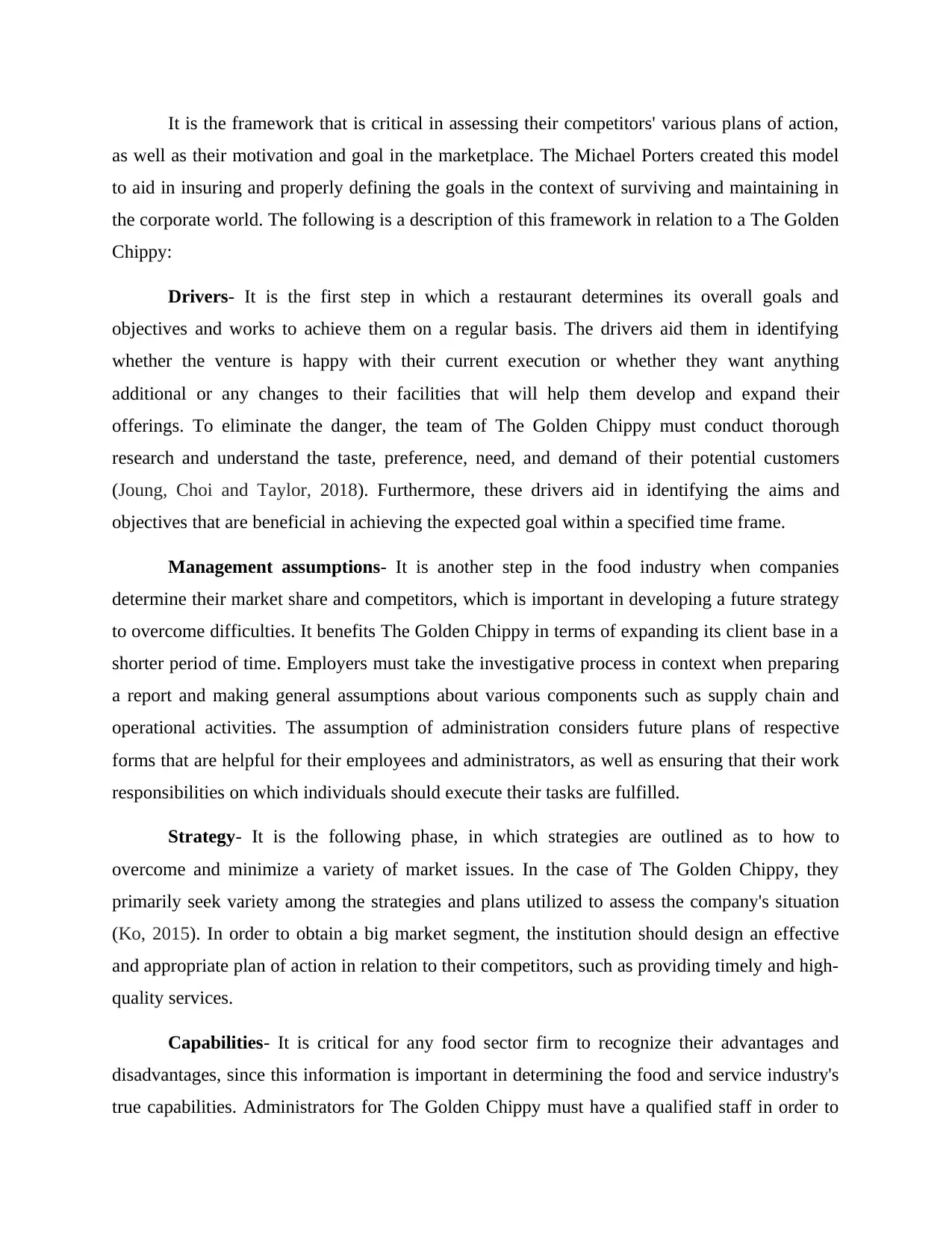
It is the framework that is critical in assessing their competitors' various plans of action,
as well as their motivation and goal in the marketplace. The Michael Porters created this model
to aid in insuring and properly defining the goals in the context of surviving and maintaining in
the corporate world. The following is a description of this framework in relation to a The Golden
Chippy:
Drivers- It is the first step in which a restaurant determines its overall goals and
objectives and works to achieve them on a regular basis. The drivers aid them in identifying
whether the venture is happy with their current execution or whether they want anything
additional or any changes to their facilities that will help them develop and expand their
offerings. To eliminate the danger, the team of The Golden Chippy must conduct thorough
research and understand the taste, preference, need, and demand of their potential customers
(Joung, Choi and Taylor, 2018). Furthermore, these drivers aid in identifying the aims and
objectives that are beneficial in achieving the expected goal within a specified time frame.
Management assumptions- It is another step in the food industry when companies
determine their market share and competitors, which is important in developing a future strategy
to overcome difficulties. It benefits The Golden Chippy in terms of expanding its client base in a
shorter period of time. Employers must take the investigative process in context when preparing
a report and making general assumptions about various components such as supply chain and
operational activities. The assumption of administration considers future plans of respective
forms that are helpful for their employees and administrators, as well as ensuring that their work
responsibilities on which individuals should execute their tasks are fulfilled.
Strategy- It is the following phase, in which strategies are outlined as to how to
overcome and minimize a variety of market issues. In the case of The Golden Chippy, they
primarily seek variety among the strategies and plans utilized to assess the company's situation
(Ko, 2015). In order to obtain a big market segment, the institution should design an effective
and appropriate plan of action in relation to their competitors, such as providing timely and high-
quality services.
Capabilities- It is critical for any food sector firm to recognize their advantages and
disadvantages, since this information is important in determining the food and service industry's
true capabilities. Administrators for The Golden Chippy must have a qualified staff in order to
as well as their motivation and goal in the marketplace. The Michael Porters created this model
to aid in insuring and properly defining the goals in the context of surviving and maintaining in
the corporate world. The following is a description of this framework in relation to a The Golden
Chippy:
Drivers- It is the first step in which a restaurant determines its overall goals and
objectives and works to achieve them on a regular basis. The drivers aid them in identifying
whether the venture is happy with their current execution or whether they want anything
additional or any changes to their facilities that will help them develop and expand their
offerings. To eliminate the danger, the team of The Golden Chippy must conduct thorough
research and understand the taste, preference, need, and demand of their potential customers
(Joung, Choi and Taylor, 2018). Furthermore, these drivers aid in identifying the aims and
objectives that are beneficial in achieving the expected goal within a specified time frame.
Management assumptions- It is another step in the food industry when companies
determine their market share and competitors, which is important in developing a future strategy
to overcome difficulties. It benefits The Golden Chippy in terms of expanding its client base in a
shorter period of time. Employers must take the investigative process in context when preparing
a report and making general assumptions about various components such as supply chain and
operational activities. The assumption of administration considers future plans of respective
forms that are helpful for their employees and administrators, as well as ensuring that their work
responsibilities on which individuals should execute their tasks are fulfilled.
Strategy- It is the following phase, in which strategies are outlined as to how to
overcome and minimize a variety of market issues. In the case of The Golden Chippy, they
primarily seek variety among the strategies and plans utilized to assess the company's situation
(Ko, 2015). In order to obtain a big market segment, the institution should design an effective
and appropriate plan of action in relation to their competitors, such as providing timely and high-
quality services.
Capabilities- It is critical for any food sector firm to recognize their advantages and
disadvantages, since this information is important in determining the food and service industry's
true capabilities. Administrators for The Golden Chippy must have a qualified staff in order to
Paraphrase This Document
Need a fresh take? Get an instant paraphrase of this document with our AI Paraphraser
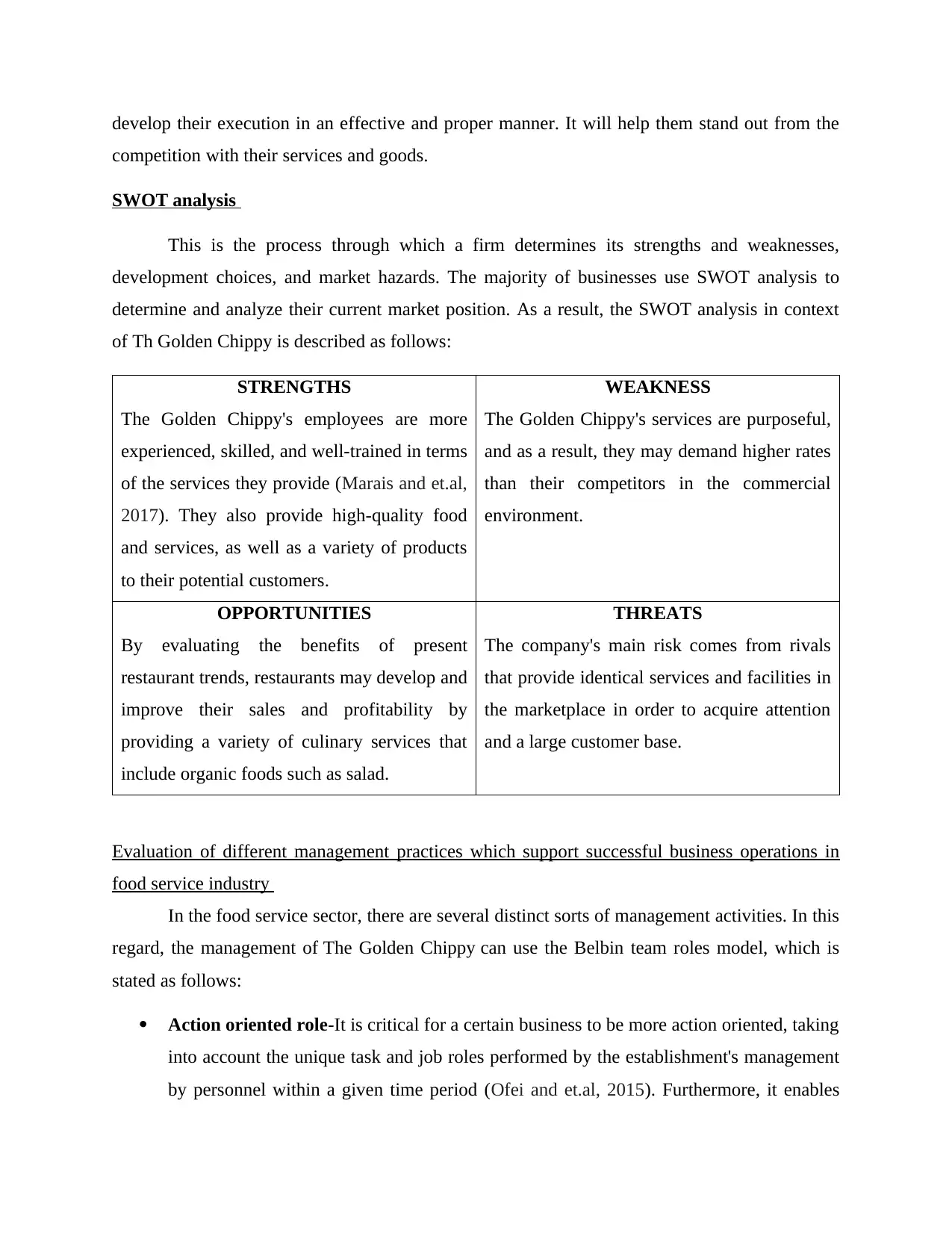
develop their execution in an effective and proper manner. It will help them stand out from the
competition with their services and goods.
SWOT analysis
This is the process through which a firm determines its strengths and weaknesses,
development choices, and market hazards. The majority of businesses use SWOT analysis to
determine and analyze their current market position. As a result, the SWOT analysis in context
of Th Golden Chippy is described as follows:
STRENGTHS
The Golden Chippy's employees are more
experienced, skilled, and well-trained in terms
of the services they provide (Marais and et.al,
2017). They also provide high-quality food
and services, as well as a variety of products
to their potential customers.
WEAKNESS
The Golden Chippy's services are purposeful,
and as a result, they may demand higher rates
than their competitors in the commercial
environment.
OPPORTUNITIES
By evaluating the benefits of present
restaurant trends, restaurants may develop and
improve their sales and profitability by
providing a variety of culinary services that
include organic foods such as salad.
THREATS
The company's main risk comes from rivals
that provide identical services and facilities in
the marketplace in order to acquire attention
and a large customer base.
Evaluation of different management practices which support successful business operations in
food service industry
In the food service sector, there are several distinct sorts of management activities. In this
regard, the management of The Golden Chippy can use the Belbin team roles model, which is
stated as follows:
Action oriented role-It is critical for a certain business to be more action oriented, taking
into account the unique task and job roles performed by the establishment's management
by personnel within a given time period (Ofei and et.al, 2015). Furthermore, it enables
competition with their services and goods.
SWOT analysis
This is the process through which a firm determines its strengths and weaknesses,
development choices, and market hazards. The majority of businesses use SWOT analysis to
determine and analyze their current market position. As a result, the SWOT analysis in context
of Th Golden Chippy is described as follows:
STRENGTHS
The Golden Chippy's employees are more
experienced, skilled, and well-trained in terms
of the services they provide (Marais and et.al,
2017). They also provide high-quality food
and services, as well as a variety of products
to their potential customers.
WEAKNESS
The Golden Chippy's services are purposeful,
and as a result, they may demand higher rates
than their competitors in the commercial
environment.
OPPORTUNITIES
By evaluating the benefits of present
restaurant trends, restaurants may develop and
improve their sales and profitability by
providing a variety of culinary services that
include organic foods such as salad.
THREATS
The company's main risk comes from rivals
that provide identical services and facilities in
the marketplace in order to acquire attention
and a large customer base.
Evaluation of different management practices which support successful business operations in
food service industry
In the food service sector, there are several distinct sorts of management activities. In this
regard, the management of The Golden Chippy can use the Belbin team roles model, which is
stated as follows:
Action oriented role-It is critical for a certain business to be more action oriented, taking
into account the unique task and job roles performed by the establishment's management
by personnel within a given time period (Ofei and et.al, 2015). Furthermore, it enables
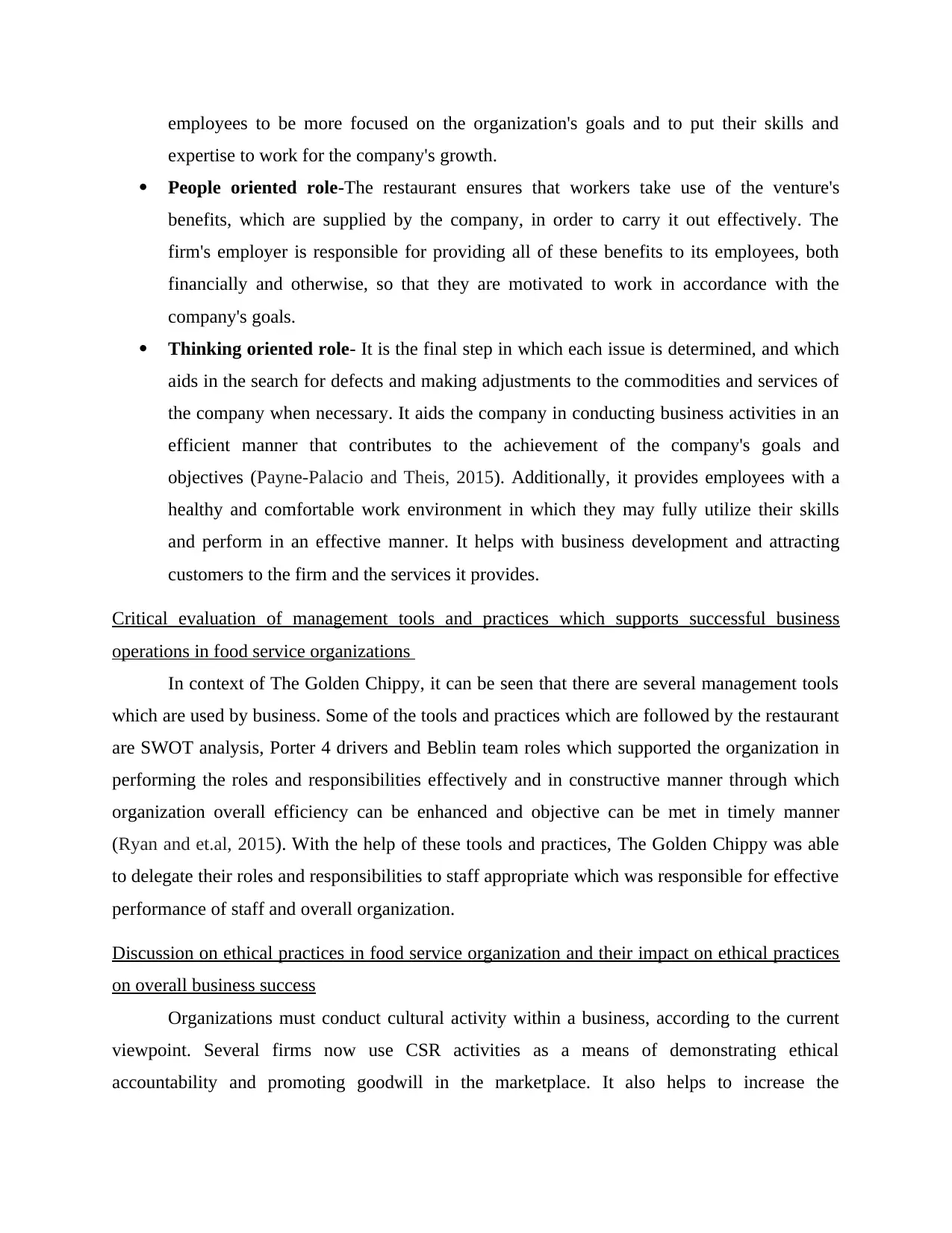
employees to be more focused on the organization's goals and to put their skills and
expertise to work for the company's growth.
People oriented role-The restaurant ensures that workers take use of the venture's
benefits, which are supplied by the company, in order to carry it out effectively. The
firm's employer is responsible for providing all of these benefits to its employees, both
financially and otherwise, so that they are motivated to work in accordance with the
company's goals.
Thinking oriented role- It is the final step in which each issue is determined, and which
aids in the search for defects and making adjustments to the commodities and services of
the company when necessary. It aids the company in conducting business activities in an
efficient manner that contributes to the achievement of the company's goals and
objectives (Payne-Palacio and Theis, 2015). Additionally, it provides employees with a
healthy and comfortable work environment in which they may fully utilize their skills
and perform in an effective manner. It helps with business development and attracting
customers to the firm and the services it provides.
Critical evaluation of management tools and practices which supports successful business
operations in food service organizations
In context of The Golden Chippy, it can be seen that there are several management tools
which are used by business. Some of the tools and practices which are followed by the restaurant
are SWOT analysis, Porter 4 drivers and Beblin team roles which supported the organization in
performing the roles and responsibilities effectively and in constructive manner through which
organization overall efficiency can be enhanced and objective can be met in timely manner
(Ryan and et.al, 2015). With the help of these tools and practices, The Golden Chippy was able
to delegate their roles and responsibilities to staff appropriate which was responsible for effective
performance of staff and overall organization.
Discussion on ethical practices in food service organization and their impact on ethical practices
on overall business success
Organizations must conduct cultural activity within a business, according to the current
viewpoint. Several firms now use CSR activities as a means of demonstrating ethical
accountability and promoting goodwill in the marketplace. It also helps to increase the
expertise to work for the company's growth.
People oriented role-The restaurant ensures that workers take use of the venture's
benefits, which are supplied by the company, in order to carry it out effectively. The
firm's employer is responsible for providing all of these benefits to its employees, both
financially and otherwise, so that they are motivated to work in accordance with the
company's goals.
Thinking oriented role- It is the final step in which each issue is determined, and which
aids in the search for defects and making adjustments to the commodities and services of
the company when necessary. It aids the company in conducting business activities in an
efficient manner that contributes to the achievement of the company's goals and
objectives (Payne-Palacio and Theis, 2015). Additionally, it provides employees with a
healthy and comfortable work environment in which they may fully utilize their skills
and perform in an effective manner. It helps with business development and attracting
customers to the firm and the services it provides.
Critical evaluation of management tools and practices which supports successful business
operations in food service organizations
In context of The Golden Chippy, it can be seen that there are several management tools
which are used by business. Some of the tools and practices which are followed by the restaurant
are SWOT analysis, Porter 4 drivers and Beblin team roles which supported the organization in
performing the roles and responsibilities effectively and in constructive manner through which
organization overall efficiency can be enhanced and objective can be met in timely manner
(Ryan and et.al, 2015). With the help of these tools and practices, The Golden Chippy was able
to delegate their roles and responsibilities to staff appropriate which was responsible for effective
performance of staff and overall organization.
Discussion on ethical practices in food service organization and their impact on ethical practices
on overall business success
Organizations must conduct cultural activity within a business, according to the current
viewpoint. Several firms now use CSR activities as a means of demonstrating ethical
accountability and promoting goodwill in the marketplace. It also helps to increase the
⊘ This is a preview!⊘
Do you want full access?
Subscribe today to unlock all pages.

Trusted by 1+ million students worldwide
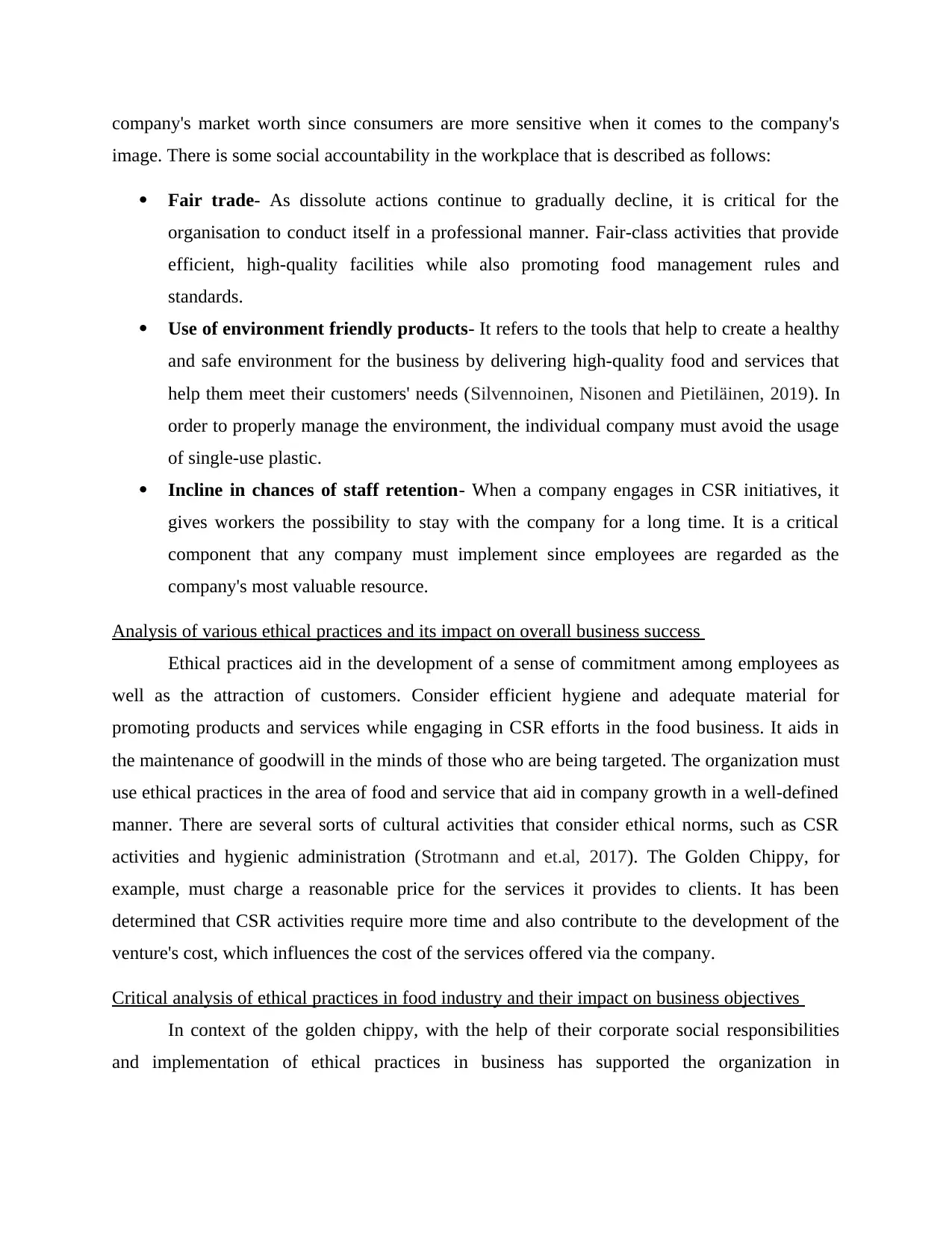
company's market worth since consumers are more sensitive when it comes to the company's
image. There is some social accountability in the workplace that is described as follows:
Fair trade- As dissolute actions continue to gradually decline, it is critical for the
organisation to conduct itself in a professional manner. Fair-class activities that provide
efficient, high-quality facilities while also promoting food management rules and
standards.
Use of environment friendly products- It refers to the tools that help to create a healthy
and safe environment for the business by delivering high-quality food and services that
help them meet their customers' needs (Silvennoinen, Nisonen and Pietiläinen, 2019). In
order to properly manage the environment, the individual company must avoid the usage
of single-use plastic.
Incline in chances of staff retention- When a company engages in CSR initiatives, it
gives workers the possibility to stay with the company for a long time. It is a critical
component that any company must implement since employees are regarded as the
company's most valuable resource.
Analysis of various ethical practices and its impact on overall business success
Ethical practices aid in the development of a sense of commitment among employees as
well as the attraction of customers. Consider efficient hygiene and adequate material for
promoting products and services while engaging in CSR efforts in the food business. It aids in
the maintenance of goodwill in the minds of those who are being targeted. The organization must
use ethical practices in the area of food and service that aid in company growth in a well-defined
manner. There are several sorts of cultural activities that consider ethical norms, such as CSR
activities and hygienic administration (Strotmann and et.al, 2017). The Golden Chippy, for
example, must charge a reasonable price for the services it provides to clients. It has been
determined that CSR activities require more time and also contribute to the development of the
venture's cost, which influences the cost of the services offered via the company.
Critical analysis of ethical practices in food industry and their impact on business objectives
In context of the golden chippy, with the help of their corporate social responsibilities
and implementation of ethical practices in business has supported the organization in
image. There is some social accountability in the workplace that is described as follows:
Fair trade- As dissolute actions continue to gradually decline, it is critical for the
organisation to conduct itself in a professional manner. Fair-class activities that provide
efficient, high-quality facilities while also promoting food management rules and
standards.
Use of environment friendly products- It refers to the tools that help to create a healthy
and safe environment for the business by delivering high-quality food and services that
help them meet their customers' needs (Silvennoinen, Nisonen and Pietiläinen, 2019). In
order to properly manage the environment, the individual company must avoid the usage
of single-use plastic.
Incline in chances of staff retention- When a company engages in CSR initiatives, it
gives workers the possibility to stay with the company for a long time. It is a critical
component that any company must implement since employees are regarded as the
company's most valuable resource.
Analysis of various ethical practices and its impact on overall business success
Ethical practices aid in the development of a sense of commitment among employees as
well as the attraction of customers. Consider efficient hygiene and adequate material for
promoting products and services while engaging in CSR efforts in the food business. It aids in
the maintenance of goodwill in the minds of those who are being targeted. The organization must
use ethical practices in the area of food and service that aid in company growth in a well-defined
manner. There are several sorts of cultural activities that consider ethical norms, such as CSR
activities and hygienic administration (Strotmann and et.al, 2017). The Golden Chippy, for
example, must charge a reasonable price for the services it provides to clients. It has been
determined that CSR activities require more time and also contribute to the development of the
venture's cost, which influences the cost of the services offered via the company.
Critical analysis of ethical practices in food industry and their impact on business objectives
In context of the golden chippy, with the help of their corporate social responsibilities
and implementation of ethical practices in business has supported the organization in
Paraphrase This Document
Need a fresh take? Get an instant paraphrase of this document with our AI Paraphraser
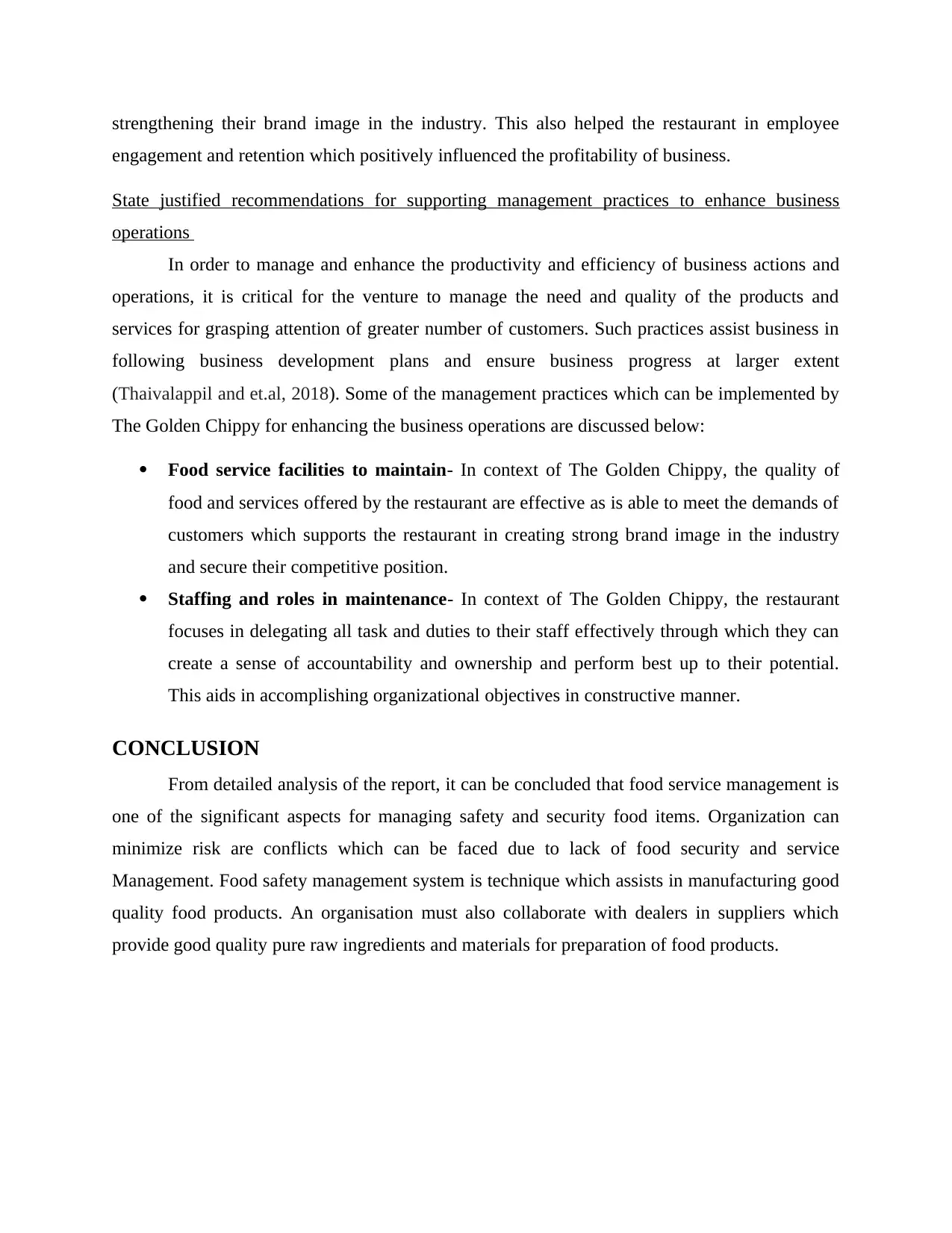
strengthening their brand image in the industry. This also helped the restaurant in employee
engagement and retention which positively influenced the profitability of business.
State justified recommendations for supporting management practices to enhance business
operations
In order to manage and enhance the productivity and efficiency of business actions and
operations, it is critical for the venture to manage the need and quality of the products and
services for grasping attention of greater number of customers. Such practices assist business in
following business development plans and ensure business progress at larger extent
(Thaivalappil and et.al, 2018). Some of the management practices which can be implemented by
The Golden Chippy for enhancing the business operations are discussed below:
Food service facilities to maintain- In context of The Golden Chippy, the quality of
food and services offered by the restaurant are effective as is able to meet the demands of
customers which supports the restaurant in creating strong brand image in the industry
and secure their competitive position.
Staffing and roles in maintenance- In context of The Golden Chippy, the restaurant
focuses in delegating all task and duties to their staff effectively through which they can
create a sense of accountability and ownership and perform best up to their potential.
This aids in accomplishing organizational objectives in constructive manner.
CONCLUSION
From detailed analysis of the report, it can be concluded that food service management is
one of the significant aspects for managing safety and security food items. Organization can
minimize risk are conflicts which can be faced due to lack of food security and service
Management. Food safety management system is technique which assists in manufacturing good
quality food products. An organisation must also collaborate with dealers in suppliers which
provide good quality pure raw ingredients and materials for preparation of food products.
engagement and retention which positively influenced the profitability of business.
State justified recommendations for supporting management practices to enhance business
operations
In order to manage and enhance the productivity and efficiency of business actions and
operations, it is critical for the venture to manage the need and quality of the products and
services for grasping attention of greater number of customers. Such practices assist business in
following business development plans and ensure business progress at larger extent
(Thaivalappil and et.al, 2018). Some of the management practices which can be implemented by
The Golden Chippy for enhancing the business operations are discussed below:
Food service facilities to maintain- In context of The Golden Chippy, the quality of
food and services offered by the restaurant are effective as is able to meet the demands of
customers which supports the restaurant in creating strong brand image in the industry
and secure their competitive position.
Staffing and roles in maintenance- In context of The Golden Chippy, the restaurant
focuses in delegating all task and duties to their staff effectively through which they can
create a sense of accountability and ownership and perform best up to their potential.
This aids in accomplishing organizational objectives in constructive manner.
CONCLUSION
From detailed analysis of the report, it can be concluded that food service management is
one of the significant aspects for managing safety and security food items. Organization can
minimize risk are conflicts which can be faced due to lack of food security and service
Management. Food safety management system is technique which assists in manufacturing good
quality food products. An organisation must also collaborate with dealers in suppliers which
provide good quality pure raw ingredients and materials for preparation of food products.
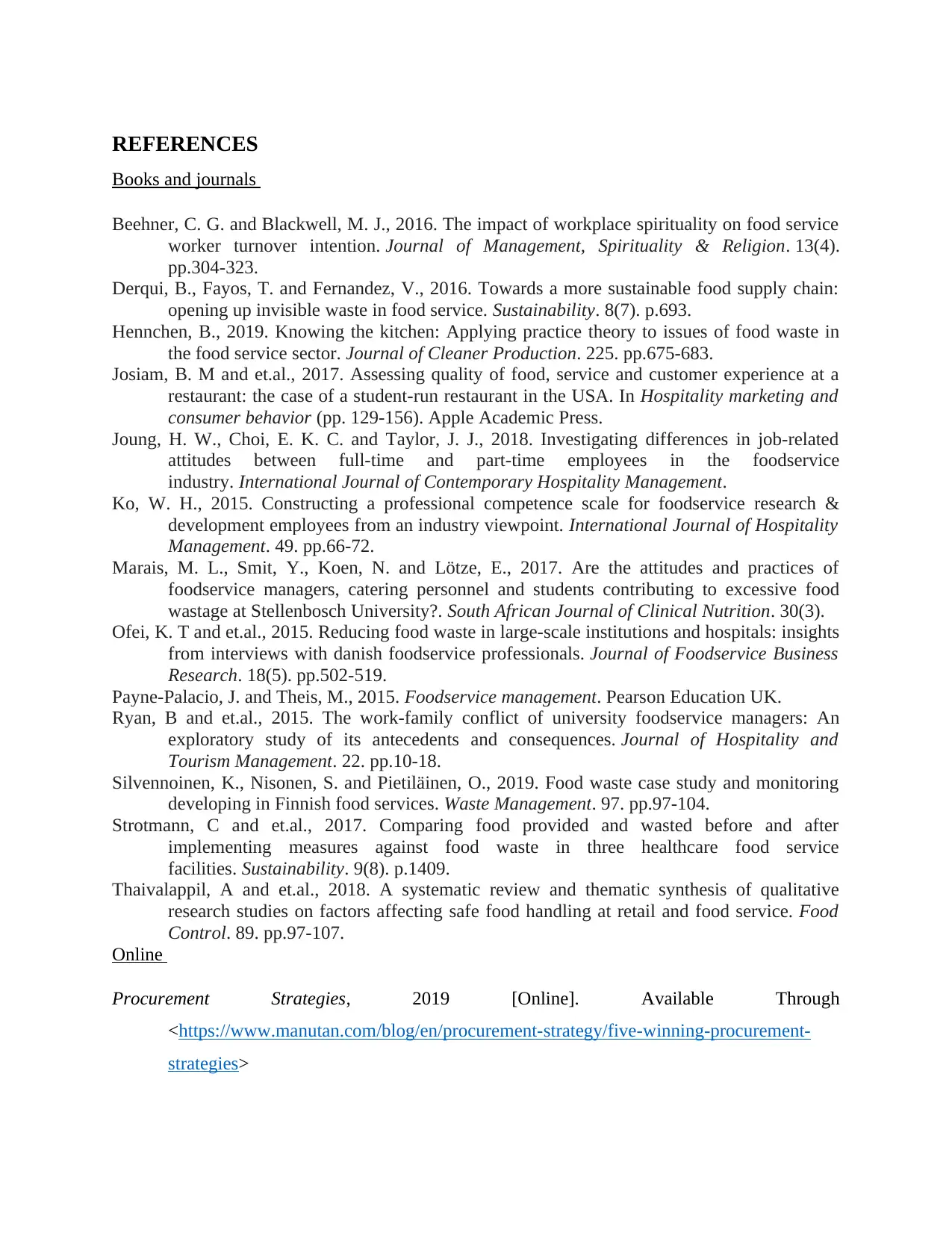
REFERENCES
Books and journals
Beehner, C. G. and Blackwell, M. J., 2016. The impact of workplace spirituality on food service
worker turnover intention. Journal of Management, Spirituality & Religion. 13(4).
pp.304-323.
Derqui, B., Fayos, T. and Fernandez, V., 2016. Towards a more sustainable food supply chain:
opening up invisible waste in food service. Sustainability. 8(7). p.693.
Hennchen, B., 2019. Knowing the kitchen: Applying practice theory to issues of food waste in
the food service sector. Journal of Cleaner Production. 225. pp.675-683.
Josiam, B. M and et.al., 2017. Assessing quality of food, service and customer experience at a
restaurant: the case of a student-run restaurant in the USA. In Hospitality marketing and
consumer behavior (pp. 129-156). Apple Academic Press.
Joung, H. W., Choi, E. K. C. and Taylor, J. J., 2018. Investigating differences in job-related
attitudes between full-time and part-time employees in the foodservice
industry. International Journal of Contemporary Hospitality Management.
Ko, W. H., 2015. Constructing a professional competence scale for foodservice research &
development employees from an industry viewpoint. International Journal of Hospitality
Management. 49. pp.66-72.
Marais, M. L., Smit, Y., Koen, N. and Lötze, E., 2017. Are the attitudes and practices of
foodservice managers, catering personnel and students contributing to excessive food
wastage at Stellenbosch University?. South African Journal of Clinical Nutrition. 30(3).
Ofei, K. T and et.al., 2015. Reducing food waste in large-scale institutions and hospitals: insights
from interviews with danish foodservice professionals. Journal of Foodservice Business
Research. 18(5). pp.502-519.
Payne-Palacio, J. and Theis, M., 2015. Foodservice management. Pearson Education UK.
Ryan, B and et.al., 2015. The work-family conflict of university foodservice managers: An
exploratory study of its antecedents and consequences. Journal of Hospitality and
Tourism Management. 22. pp.10-18.
Silvennoinen, K., Nisonen, S. and Pietiläinen, O., 2019. Food waste case study and monitoring
developing in Finnish food services. Waste Management. 97. pp.97-104.
Strotmann, C and et.al., 2017. Comparing food provided and wasted before and after
implementing measures against food waste in three healthcare food service
facilities. Sustainability. 9(8). p.1409.
Thaivalappil, A and et.al., 2018. A systematic review and thematic synthesis of qualitative
research studies on factors affecting safe food handling at retail and food service. Food
Control. 89. pp.97-107.
Online
Procurement Strategies, 2019 [Online]. Available Through
<https://www.manutan.com/blog/en/procurement-strategy/five-winning-procurement-
strategies>
Books and journals
Beehner, C. G. and Blackwell, M. J., 2016. The impact of workplace spirituality on food service
worker turnover intention. Journal of Management, Spirituality & Religion. 13(4).
pp.304-323.
Derqui, B., Fayos, T. and Fernandez, V., 2016. Towards a more sustainable food supply chain:
opening up invisible waste in food service. Sustainability. 8(7). p.693.
Hennchen, B., 2019. Knowing the kitchen: Applying practice theory to issues of food waste in
the food service sector. Journal of Cleaner Production. 225. pp.675-683.
Josiam, B. M and et.al., 2017. Assessing quality of food, service and customer experience at a
restaurant: the case of a student-run restaurant in the USA. In Hospitality marketing and
consumer behavior (pp. 129-156). Apple Academic Press.
Joung, H. W., Choi, E. K. C. and Taylor, J. J., 2018. Investigating differences in job-related
attitudes between full-time and part-time employees in the foodservice
industry. International Journal of Contemporary Hospitality Management.
Ko, W. H., 2015. Constructing a professional competence scale for foodservice research &
development employees from an industry viewpoint. International Journal of Hospitality
Management. 49. pp.66-72.
Marais, M. L., Smit, Y., Koen, N. and Lötze, E., 2017. Are the attitudes and practices of
foodservice managers, catering personnel and students contributing to excessive food
wastage at Stellenbosch University?. South African Journal of Clinical Nutrition. 30(3).
Ofei, K. T and et.al., 2015. Reducing food waste in large-scale institutions and hospitals: insights
from interviews with danish foodservice professionals. Journal of Foodservice Business
Research. 18(5). pp.502-519.
Payne-Palacio, J. and Theis, M., 2015. Foodservice management. Pearson Education UK.
Ryan, B and et.al., 2015. The work-family conflict of university foodservice managers: An
exploratory study of its antecedents and consequences. Journal of Hospitality and
Tourism Management. 22. pp.10-18.
Silvennoinen, K., Nisonen, S. and Pietiläinen, O., 2019. Food waste case study and monitoring
developing in Finnish food services. Waste Management. 97. pp.97-104.
Strotmann, C and et.al., 2017. Comparing food provided and wasted before and after
implementing measures against food waste in three healthcare food service
facilities. Sustainability. 9(8). p.1409.
Thaivalappil, A and et.al., 2018. A systematic review and thematic synthesis of qualitative
research studies on factors affecting safe food handling at retail and food service. Food
Control. 89. pp.97-107.
Online
Procurement Strategies, 2019 [Online]. Available Through
<https://www.manutan.com/blog/en/procurement-strategy/five-winning-procurement-
strategies>
⊘ This is a preview!⊘
Do you want full access?
Subscribe today to unlock all pages.

Trusted by 1+ million students worldwide
1 out of 18
Related Documents
Your All-in-One AI-Powered Toolkit for Academic Success.
+13062052269
info@desklib.com
Available 24*7 on WhatsApp / Email
![[object Object]](/_next/static/media/star-bottom.7253800d.svg)
Unlock your academic potential
Copyright © 2020–2025 A2Z Services. All Rights Reserved. Developed and managed by ZUCOL.




